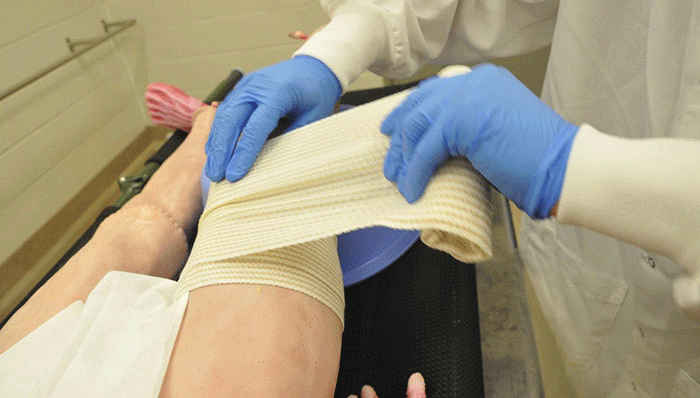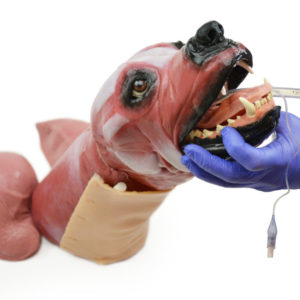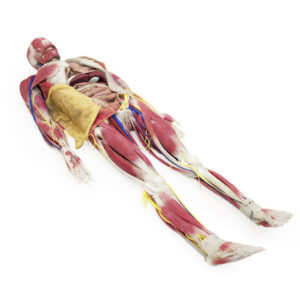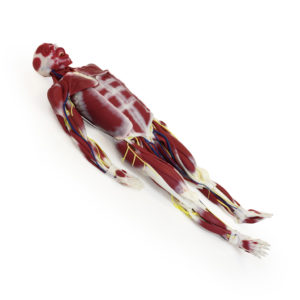SynDaver Labs’ tenth U.S. Patent (No 8,801,438) was issued today. This patent covers anatomic models that comprise components that simulate human or non-human animal components. The models may be used for development, experimentation, or training in the field of orthopedic surgical devices, and/or implant devices. The models may also be used for training of students in the medical field for procedures performed in practice, such as for example drawing blood from a patient, or placing a central line in a carotid artery of a patient. In exemplary embodiments, the models comprise structures such as cartilage, tendons, ligaments, organs, luminal structures, and muscles that are made of hydrogel materials.
News
SynDaver Synthetic Human Supporting Wound Research

Scientists at Naval Medical Research Unit San Antonio (NAMRU-SA) are among the first to use the SynDaver Synthetic Human (SSH), an anatomically accurate synthetic human replica, to support test and evaluation efforts that aim to characterize the performance and effectiveness of various treatment modalities used in combat casualty care.
Archives of Plastic Surgery: A Cost Analysis
Development of a Five-Day Basic Microsurgery Simulation Training Course: A Cost Analysis
The widespread use of microsurgery in numerous surgical fields has increased the need for basic microsurgical training outside of the operating room. The traditional start of microsurgical training has been in undertaking a 5-day basic microsurgery course. In an era characterised by financial constraints in academic and healthcare institutions as well as increasing emphasis on patient safety, there has been a shift in microsurgery training to simulation environments. This paper reviews the stepwise framework of microsurgical skill acquisition providing a cost analysis of basic microsurgery courses in order to aid planning and dissemination of microsurgical training worldwide.
SynDaver Labs on Crossbones
The SynDaver Synthetic Human made the first of many to come, appearances on NBC’s Crossbones Friday, May 31.
Synthetic Human Arrives in Chesterfield
When it comes to preparing students for careers in medical-related fields, mannequins are so yesterday.
Salt + Water + Fibers = Synthetic Human Body
Models used for testing medical devices range from the gold standard – a live human – to inadequate models that design engineers assemble themselves. Some even resort to using twisted up pieces of rubber tubing to simulate vessels for design validation testing. Obviously, this approach misguided, not just for medical devices but for any product requiring testing. Engineers relying on data from a poorly conceived test environment may move a design in the wrong direction, leading to increased development costs or a product never reaching its final stage.
NCCC Surgical Technology and SynDaver
Surgical technology instructors along with a practicing surgeon are able to use the SSH in our state of the art simulated operating room, to mimic real surgical cases in a step by step fashion, to greatly enhance student learning. This allows students to completely prepare for and assist with surgeries as they would realistically progress, prior to entering the clinical site operating rooms. Rather than seeing the anatomy and surgical methods used in this case on our SSH, this video allows students to see the functions of a surgical technologist providing perioperative patient care and surgeon assistance. All members of the surgical team on this video are Certified Surgical Technologists except for the surgeon (in the “stars” cap). The scenario is true to the surgical experience in a real operating room, on a real patient.
Demonstration of Synthetic Cadaver at Medical School
Medical education at the University of Arizona College of Medicine – Phoenix has received a big boost with the latest in simulation technology from SynDaver™ Labs – and the city will get an economic boost as well.
Phoenix Mayor Greg Stanton, UA College of Medicine – Phoenix Dean Stuart D. Flynn, MD, and SynDaver™ Labs’ President Christopher Sakezles, PhD, on Wednesday, announced an exclusive collaboration between the medical school and Tampa, Fla.,-based SynDaver™ Labs. Sakezles said it could create up to 1,000 jobs over the next several years.
“We are bringing SynDaver to the forefront of medical education,” said Teresa Wu, MD, an emergency room physician at Maricopa Medical Center and faculty member of the college. “We are developing a team of syndaver practitioners that is going to help enhance medical education and improve patient safety.”
New Facilities
SynDaver™ Labs’ started operations today at a new 250000 SF state of the art facility in Tampa, Florida. The new facility includes a simulation center and consolidates all engineering, manufacturing, and sales operations for the Eastern United States. Our design facilities in Arizona and Oregon will remain open and continue to grow.
Our 9th Patent
SynDaver Labs’ ninth U.S. Patent (No 8,512,044) was allowed today. The patent covers the design and manufacturing of synthetic human anatomy models which possessing a level of correlation to dielectric properties of human or nonhuman animal tissues that allows them to be substituted for either a live animal, an animal cadaver, or a human cadaver in the testing of medical devices.






